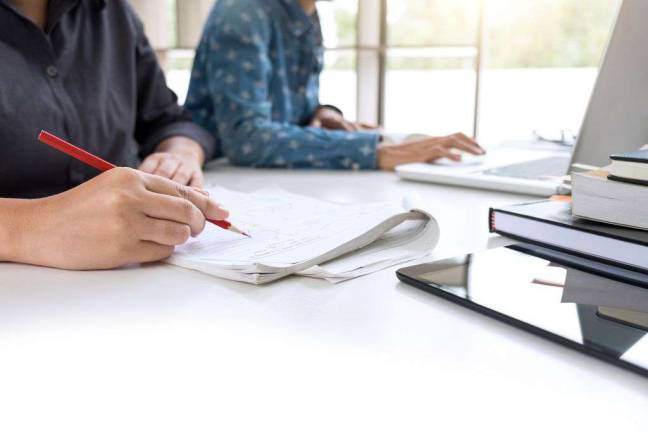For centuries students wrote their classroom notes, whether on paper or papyrus. Now, with the aid of digital devices, they can type them on laptops or record their teachers on audio or video. Some schools no longer even teach cursive. But how much have things really changed?
Using a laptop is increasingly popular among today's students. But, as researchers Pam Mueller and Daniel Oppenheimer have found, nothing reinforces learning like writing it down, pen to paper. That's because the notetaker is forced to process the information more deeply. To keep up, students who take notes by hand must continually paraphrase what they are hearing. Typing notes on laptops, on the other hand, is much faster and so results in “shallower processing,” the researchers write.
The students at Kittatinny Regional High School in Newton, N.J., especially in the upper grades, are big notetakers — sometimes using cursive, more often printing — according to Carol Fishbone, who consulted her fellow teachers at the school.
“My kids take notes on their own all the time,” one teacher writes, with the notes serving to spark classroom discussion. “They are required to read the class novel at home and annotate within a journal to bring to class,” while also writing down important facts not found in the book.
Notetaking is valued in classes other than English or history. One Kittatinny teacher who teaches eleventh- and twelfth-grade math “strongly encourages notetaking” and offers an optional notebook assessment at the end of each marking period equivalent to a small quiz grade. Many teachers at the school do notebook checks. One does it “to be sure they write down the main points of the chapter.”
Leslie Lordi, who teaches at Delaware Valley High School in Milford, Pa., said each class and teacher approaches notetaking differently.
“I have students who still use cursive writing and some who do not,” says Leslie Lordi, who teaches at Delaware Valley High School in Milford, Pa. “My own children are in the third and fourth grade, and they both have practiced cursive because I see worksheets that they bring home.”
“In my English and journalism classes, students take notes in their notebooks when I need them to. My students do not take notes on a laptop. I recommend students doing what works best for them.”
From lecture hall to workshopClassroom teaching has also changed over the years. This too affects how, or whether, students take notes. Workshops and study groups, which foster greater student interaction and hands-on learning than “talk and chalk,” are far more prevalent today than in earlier generations.
Marilyn Brozycki Smith of Warwick Valley High School in Warwick, N.Y., says her students, “to some extent, still do it the old-fashioned way, with pen and paper, jotting down thoughts and ideas from class discussion on a sheet of paper.”
But, she said, there is far less lecture going on in the classroom today. “And when there is lecture, typically it is accompanied by a handout, which probably includes whatever information a student should have in his or her notes,” she said.
Smith said teachers frequently post notes electronically using Google Classroom or a Weebly page. Students are then able to return to this material when studying on educational platforms, she said.
Students often type up their notes on laptops, especially if they are going to be used later in a typed paper or electronic presentation, said Smith.
Another method is a hybrid of teacher-provided notes and student notes that create a kind of dialog.
“This year I am handing out copies of my presentations/notes with blank lines to the right of each slide,” says a teacher at Kittatinny. “The goal is to have the kids engage in class discussions and write down examples or notes from the discussion they think will help them. Some are taking additional notes. I am also including several questions to be completed as a summary/ exit ticket or a do now that hits key points from the lesson. So far the feedback has been positive.”
But even with laptops definitely in the mix, students today still do much of their notetaking the way it’s always been done — attending to what their teachers say, pen in hand, and making it their own by putting it on paper.
And, unlike most other features of modern life, pen-and-paper notetaking will not be stopped by a depleted battery.
